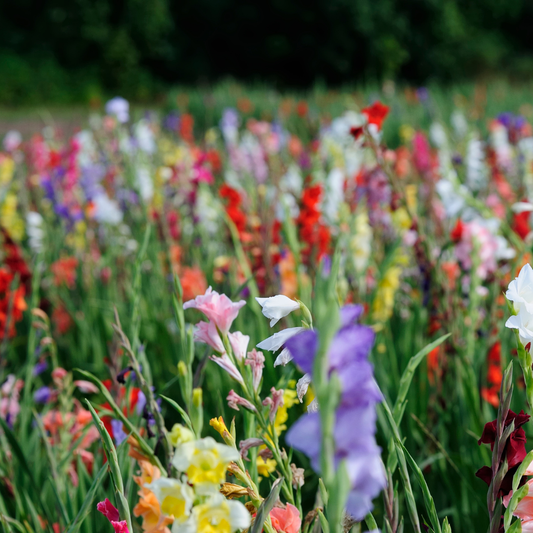
When to Plant Flower Bulbs? The Complete Guide
Share
Flower bulbs are an easy way to bring your garden to life in spring or autumn. But to ensure they bloom beautifully, it's important to plant them at the right time and in the right way. This guide will help you discover when and how to plant flower bulbs, with specific tips for each variety.
Interested in more plant guides? See also:
- When to plant which plants? An overview
- When to plant tulips?
- When to plant lavender?
- When to plant strawberries?
- When to plant dahlias?
Types of flower bulbs
There are different types of flower bulbs, each with its own planting time and care requirements. The main types are:
- Spring bloomers: Plant these in the fall and they'll bloom in the spring. Examples include tulips, daffodils, hyacinths, and crocuses (spring variety).
- Summer bloomers: Plant these in the spring and they bloom in the summer. Examples include dahlias, begonias, and gladioli.
- Autumn bloomers: Plant these in the summer and they will bloom in the fall. Examples include autumn crocuses and amaryllis.
When to plant flower bulbs?
Depending on the species, you plant flower bulbs at different times:
- Spring bloomers (such as tulips and daffodils): Plant between September and November for spring blooms.
- Summer bloomers (such as dahlias and gladioli): Plant between April and June for summer blooms.
- Autumn bloomers (such as autumn crocuses): Plant between August and September for autumn flowering.
How much space between plantings and why?
Planting distance varies by species, but some guidelines are:
- Small flower bulbs: Keep 5-10 cm between the bulbs.
- Medium-sized flower bulbs: Keep 10-15 cm between the bulbs.
- Large flower bulbs: Keep 15-20 cm between the bulbs.
By leaving enough space, you prevent the bulbs from crowding each other and the roots have enough room to develop.
How to plant flower bulbs?
Follow these steps for successful planting of flower bulbs:
- Choose the right location: Flower bulbs grow best in a sunny spot with well-drained soil.
- Prepare the soil: Loosen the soil and add compost for extra nutrients.
- Planting depth: Plant the bulbs approximately twice as deep as the bulb itself is tall. For small bulbs, this is 5 cm deep, for large bulbs, 15 cm deep.
- Position the bulb correctly: Place the point up and the root side down.
- Covering: Cover the bulbs with soil and press lightly.
- Watering: Provide plenty of water immediately after planting, especially for spring bloomers.
How do I recognize flower bulbs?
Flower bulbs usually have a scale-like, round shape with a pointed end and a wide base where the roots will grow. They feel firm and often have a dry, papery outer layer.
How do I plant flower bulbs in open ground?
Flower bulbs thrive in the open ground if you follow these steps:
- Choose a sunny spot and work compost or organic fertilizer into the soil for extra nutrition.
- Prevent rot: Make sure the soil drains well, because flower bulbs rot quickly in soil that is too wet.
- Protect them from frost: For vulnerable species, a layer of mulch can help keep the soil temperature stable.
Tips for colorful and healthy flowering
Want to make your flower bulbs grow as well as possible? Then follow these tips:
- Companion plants: Combine early and late bloomers for a long flowering period.
- Remove spent flowers: This helps direct energy to the bulb for the next flowering period.
- Plant at different depths: This gives a playful and full flowering effect in your garden.
Table: When to plant flower bulbs?
| Kind | Best planting month | Annual? | Distance between plants | Can it hibernate? |
|---|---|---|---|---|
| Tulips | September - November | 1-year-old | 10-15 cm | No |
| Daffodils | September - November | 1-year-old | 10-15 cm | No |
| Hyacinths | September - November | 1-year-old | 10-15 cm | No |
| Crocuses (spring) | September - November | 1-year-old | 5-10 cm | No |
| Crocuses (autumn) | August - September | 1-year-old | 5-10 cm | No |
| Dahlias | April - June | 1-year-old | 40-50 cm | No |
| Gladioli | April - June | 1-year-old | 10-15 cm | No |
| Amaryllis | October - November | 1-year-old | 15-20 cm | No |
This guide will tell you exactly when and how to plant flower bulbs for a colorful garden full of flowers. Want to learn more about other plants? Be sure to check out our other guides via the links above. Happy gardening!



